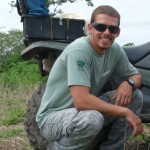

The Mabuya (Trachylepis atlantica) is a little known endemic skink and a flagship-species of the Fernando de Noronha archipelago. Here Vinícius is pioneering work to understand this species and develop a viable long term management plan. Here’s his story!


Vinícius P. O Gasparotto
Mabuya (Trachylepis atlantica)
Fernando de Noronha
Twitter: @Ilha_de_Noronha
The Mabuya (Trachylepis atlantica) is a little known endemic skink and a flagship-species of the Fernando de Noronha archipelago. Here Vinícius is pioneering work to understand this species and develop a viable long term management plan. Here’s his story!
Hi Vinícius, can you tell us a little about your research background?
I studied veterinary medicine after which I studied for a master’s degree specialising in rattlesnake venom and stem cells. Nowadays, I am currently a researcher with the Brazilian Anteater Project (Projeto Tamanduá) and a researcher at TRÍADE (Brazilian Institute for Conservation Medicine). Alongside this, I am working with invasive species in Fernando de Noronha [off the coast of Brazil], working particularly on trying to understand the threats to a small endemic skink – the Mabuya – found on the archipelago. Finally, this year I started my PhD at Department of Preventive Veterinary Medicine (University of São Paulo – USP) in order to answer many questions about this unknown species and create management options for their conservation.
Phew! You sound very busy! Can you tell us more about the Mabuya?
The Mabuya (Trachylepis atlantica), is a flagship-species of the Fernando de Noronha archipelago and they have an important biological function in this restricted and reduced environment. An example of this, is the occurrence of tree pollination of flowers “mulungu” (Erythrina velutina) undertaken by the skink, which run its inflorescences in search of nectar and water accumulated in the flower base, making it one of the only known reptiles pollinated. There is no genus Trachylepis in Brazilian continental land, meaning this species not only endemic to the island, but the only representative of this genus in the country.
Considering this, and the fact that this endemic species is on presents in such a small area, there is a great importance of placing it on the red list of threatened animals, and for that we need more studies on this species. One of the reasons that it is declining, is probably due to the large number predators that are present on the islands.
The project aims to investigate the structure and dynamics of the only population of Mabuya in the world, to obtain data on this populations’ health status, describe the reproductive biology of the species and estimate the impact of invasive species on the skink.
Fernando de Noronha archipelago sounds like a unique environment?
Fernando de Noronha belongs to the Brazilian state of Pernambuco, and is situated in the Atlantic Ocean, about 545km northeast of the country. The oceanic archipelago consists of 21 volcanic islands and islets and the climate is tropical with dry seasons and rainy seasons well defined.
As well as being a UNESCO world heritage site, the group of islands is considered a National Marine Park, and an important breeding site for several species of birds, as well as habitat for endemic reptiles. All these native species are suffering the negative impacts of the presence of invasive animals brought from the continent, as the domestic cat, rats and the Tegu lizard (Salvator merianae). It is believed that extinction of the only endemic mammal from archipelago, Noronhomys vespuccii, a rodent that was cited by the first Europeans to arrive at the archipelago, has been due to competition or introduction of new diseases brought by invasive species, especially cats and rats.
It certainly sounds like a special place to work! What is an average day in the field like?
The Mabuya are diurnal and the best schedule of work is during the warmer periods of the day, because the skinks have higher activity. The work is carried out through long walks along the full extent of the main island and secondary islands. Often we go to the secondary islands in small boats to study the animals that are there. These islands are not inhabited, the animals are isolated from humans and we need special permits to conduct studies there. Getting to these uninhabited islands is a challenge, often we need to jump into the water and swim to the rocks because there are no appropriate places for boarding/landing. We spend all day collecting data and biological material. We have to ensure that we have enough supplies – especially plenty of water due to extreme heat!
What are the highlights?
I enjoy working in Noronha for the place and its natural beauty are fantastic! Local inhabitants are friendly and welcoming. They have incredible stories about the animals and the first inhabitants of the island. The feeling of being able to help a species that is clearly in danger is extremely rewarding. Unfortunately, due to lack of data, this animal is not included in the endangered species list, and since it is restricted and isolated in a small area of oceanic land, and is the only known population, it should definitely be considered a species at risk!
At the end of my research, scientific papers will be published, providing scientific suggestions for conservation management. This plan, developed in partnership with environmental analysts, administrative authorities and the local population will ensure the preservation of this endemic species in the archipelago.
What are the challenges?
One of the most difficult aspects is the logistics involved to get to and stay in the archipelago. Distance and the high price of flights, meals and accommodation is the most difficult and limiting factor to undertaking fieldwork in this area.
Environmental conditions are also difficult. Because it is a volcanic island, much of the archipelago has high cliffs and many loose stones, which can be problematic or unsafe. Little information about the species is also a major challenge. We have to find out all of the basic information and answer questions designed to achieve the objective of the research.
What are the top five things you wish you had known before you started your fieldwork?
I believe I can sum up five things in a single desire! I would like to be able to stay longer every year in the archipelago. Today we are doing two annual campaigns, 30 days per campaign. If we had the financial means to go four times a year, that would be excellent. In this were the case, we would have more rapid responses to our questions, and thus being able to prepare management plans and actions for the conservation of the skink sooner.
Lastly, are you optimistic for the future conservation of the Mabuya lizard?
The Mabuya’s ancestors arrived in the archipelago and its speciation occurred in this environment about 6 million years ago, probably without any predators. We can see that these animals do not yet have proper defensive behavior. So, with the arrival of invasive species, its population is being greatly affected. Many individuals are being preyed daily! We believe that at least 800 Mabuya’s are preyed every day by cats. However, with the results from the research, the dissemination of such information, environmental education and the establishment of plans and goals to mitigate these impacts together with ICMBio [environmental organisation of the Brazilian Government] and local administrators, I believe the future of skink is promising!
Thank you Vinícius, and good luck!
One thought on “Vinícius P. O Gasparotto: The endemic skink of Fernando de Noronha”